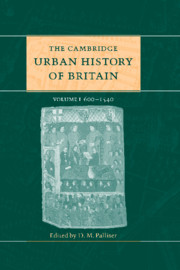Book contents
- Frontmatter
- Part I Introductory
- Part II The early middle ages 600–1300
- Part III The later middle ages 1300–1540
- 12 General survey 1300–1540
- 13 Government, power and authority 1300–1540
- 14 The economy of British towns 1300–1540
- 15 Urban culture and the Church 1300–1540
- 16 The built environment 1300–1540
- 17 London 1300–1540
- 18 The greater towns 1300–1540
- 19 Port towns
- 20 Small towns 1270–1540
- Part IV Regional surveys
- Part V Conclusion
- Appendix: Ranking lists of English medieval towns
- Select bibliography
- Index
- References
13 - Government, power and authority 1300–1540
from Part III - The later middle ages 1300–1540
Published online by Cambridge University Press: 28 March 2008
- Frontmatter
- Part I Introductory
- Part II The early middle ages 600–1300
- Part III The later middle ages 1300–1540
- 12 General survey 1300–1540
- 13 Government, power and authority 1300–1540
- 14 The economy of British towns 1300–1540
- 15 Urban culture and the Church 1300–1540
- 16 The built environment 1300–1540
- 17 London 1300–1540
- 18 The greater towns 1300–1540
- 19 Port towns
- 20 Small towns 1270–1540
- Part IV Regional surveys
- Part V Conclusion
- Appendix: Ranking lists of English medieval towns
- Select bibliography
- Index
- References
Summary
The nature and development of late medieval town government remains an extremely controversial issue amongst urban historians. Was this, as some claim, a time of growing exclusivity and oligarchy or was it an era of increasing popular participation in town government? Was urban political conflict, particularly that of the communitas against the mercantile oligarchy, the inevitable result of opposing class interests or were shared ideological norms and a sense of civic community effective in legitimating the authority of town rulers and minimising conflict? Is the concept of ‘oligarchy’ itself a loaded anachronism when applied to a society which saw the rule of the rich as ‘aristocratic’ (i.e. rule by the ‘better sort’ for the ‘common profit’) rather than as ‘oligarchic’ (i.e rule by the self-interested few)? Did urban political conflicts revolve around the corruption of individual rulers rather than issues of political principle or a desire for structural change in town government?
the extent of self-government
The survival of the records of civic administration generated by the self-governing royal boroughs has tended to give a misleading impression of late medieval town government. In fact, in England, only a minority of towns achieved the degree of autonomy enjoyed by royal towns such as York and Winchester, where the burgesses elected their own mayor and bailiffs to govern the town, to collect royal revenues and account for the fee-farm, and to administer justice in the borough court. By the thirteenth century, many of these self-governing towns had acquired a ‘mayor's council’ but, in the later middle ages, many added a second or ‘common’ council.
- Type
- Chapter
- Information
- The Cambridge Urban History of Britain , pp. 291 - 312Publisher: Cambridge University PressPrint publication year: 2000
References
- 2
- Cited by



